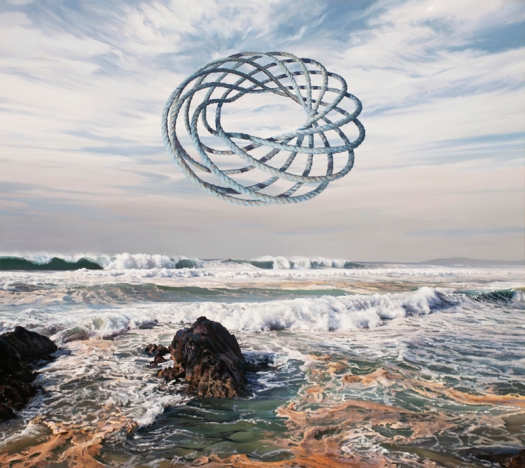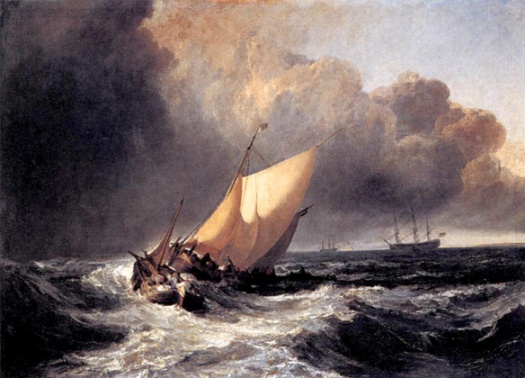When I first saw Hobie Porter‘s work I wasn’t sure what I was looking at – a ‘straight’ photograph, a digital mash-up or what. He is of course a landscape painter, and his work is a juxtaposition of the grand landscape with artifacts that he’s found. Perhaps not surprisingly what caught my attention are his seascapes in which he incorporates old ropes, propellers and a variety of other things that he’s found at the beach. One of the advantages that painters have over photographers is that they are able to paint what ever they imagine and so I had assumed that these beach artifacts were figments of Porter’s imagination. Not so. While there may be an element of interpretation he actually collected these objects for use as reference and then for the exhibition shown in the video below displays them as part of the exhibition. Check out the videos of Porter at work and of him discussing his art below.
Friday Inspiration: J.M.W. Turner
The image above was the first painting that I can really remember having paid any attention to. It was a figure in an encyclopedia of steam engines that I had when I was much younger and I didn’t get it at all. It took me a long time to realize that what I was looking at was a steam engine, a Great Western train crossing a viaduct, even though there was accompanying text that described the image. I didn’t get it at all. It didn’t look like a steam engine, a train or anything that I’d ever seen for that matter. That of course was the point. It wasn’t supposed to look like something it was an attempt to capture a mood, a sensation, a feeling. Looking at ‘Steam, Speed, Rain’ now I would say that Turner nailed it perfectly. At the time Turner made this painting in 1844 he would have been around 69, his position in the art community firmly established he was well positioned to push the boundaries of what was accepted as the norm. I suspect that many of the people at the time didn’t appreciate what he was trying to achieve and ridiculed him for his efforts. Even so, he pursued the development of this style of removing precise forms from his work leaving color and light to give a sense of the mood he was trying to evoke for the last two decades of his career.
Turner was one of the first artists to ensure that his work would be preserved following his death and so there is a rich archive of material from sketchbooks to watercolors and oils to study. I doubt how he got from the work that got him elected to the Royal Academy at the ripe old age of 26 to that of his later years will be clear from a study of the 40,000 or so works that he left behind.
This looks like a good year for Turner fans. There is an exhibition of his sea pictures ‘Turner and the Sea‘ now showing at the Peabody Essex Museum in Salem.
Also there is a film ‘Mr Turner‘ due to be released later in the year that stars Timothy Spall who won the best actor award at the 2014 Cannes film festival for his depiction of Turner. Check out the trailer below:
Book Comment: Landscape Meditations
I find that I can learn as much from looking at books from other visual artists as I do from photographers. One such example is ‘Landscape Meditations’ by Elizabeth Mowry, that I found recently while browsing in a local bookstore. From the introduction I knew this was a book I would gain something from when I read:
‘when one uses an idea already expressed by others, it becomes unequivocally necessary to take the idea deeper, further or in a different direction to avoid finding oneself on an inevitably dead-ended plateau with unfulfilling work that echoes refrains from someone else’s songs.’
This and other ideas in the book are very much in line with my thoughts for what I’m trying to do with my photography, to have my personality come through in my work. How to get there is a struggle that involves working hard and intentionally. I feel as though Landscape Meditations provides some framework for the exploration for those things that catch our attention, the themes that run deep in our work.
The book begins with a brief historical survey of those artists that have worked in series before launching into the 10 chapters that form the bulk of the book. The general format for each chapter is an introduction, the work and finally a section titled ‘Thoughts: artist to artist’. I found myself reading the ‘Thoughts’ sections for all the chapters first and then going back and reading the chapter through.
Thoroughly enjoyed the book and is one that I’ll keep coming back to.




